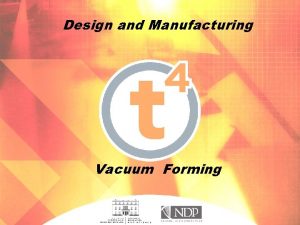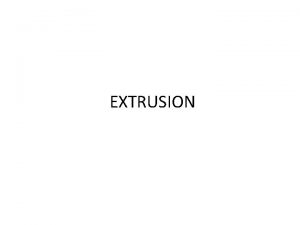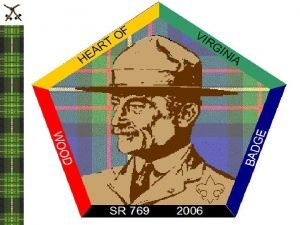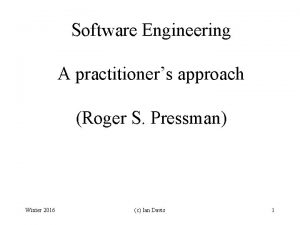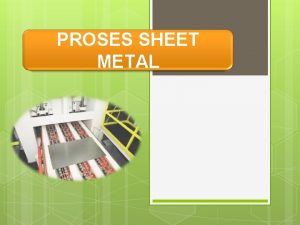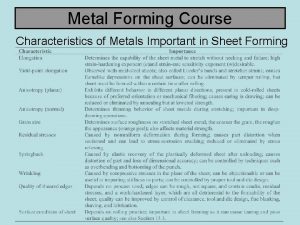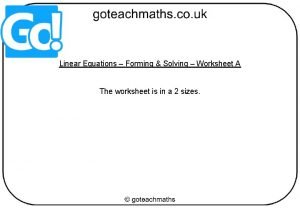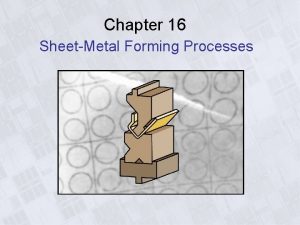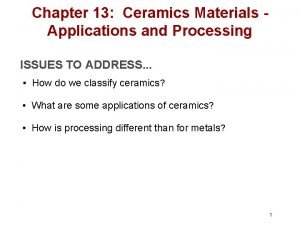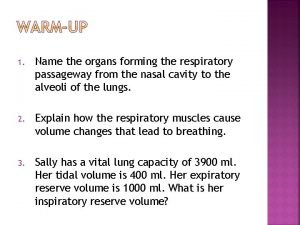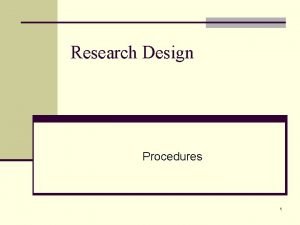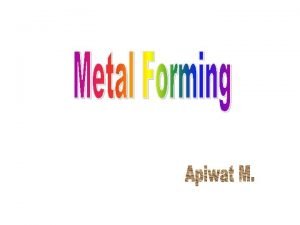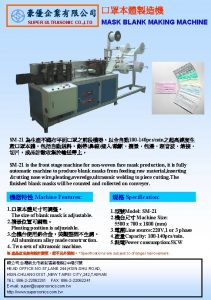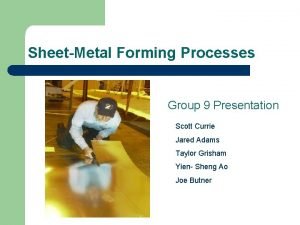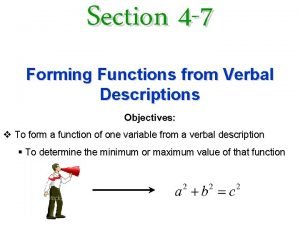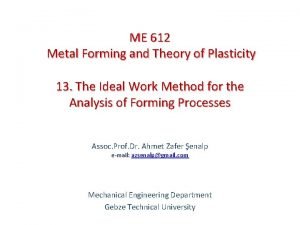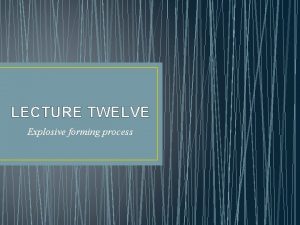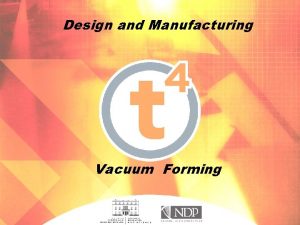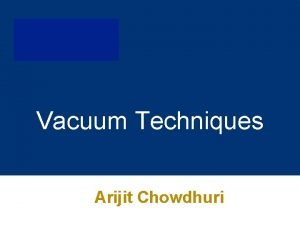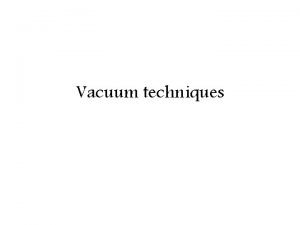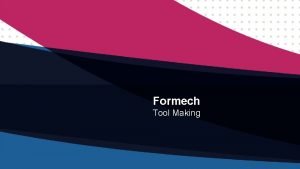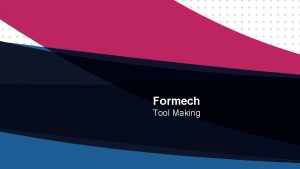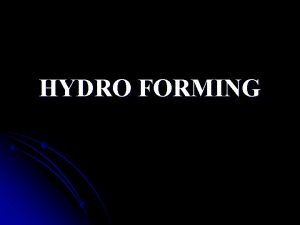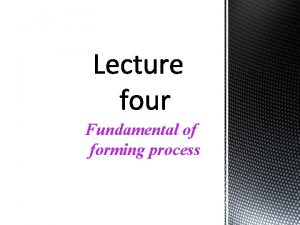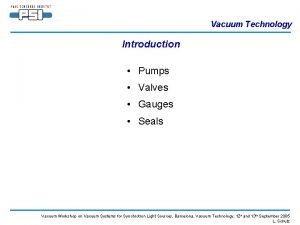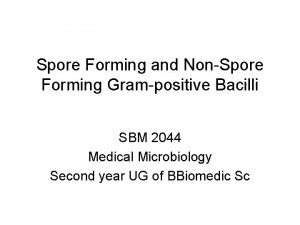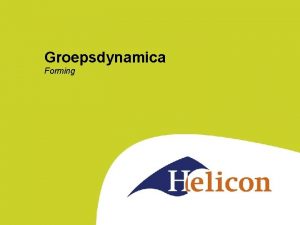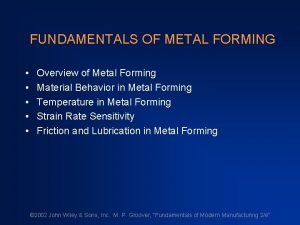Formech Introduction to Vacuum Forming Contents History of


































- Slides: 34

Formech Introduction to Vacuum Forming

Contents History of vacuum forming Vacuum forming applications Vacuum forming process Advances in vacuum forming and Formech machines Vacuum forming vs other processes Synergy of vacuum forming & 3 D printing Benefits of IMD (injection moulding and VF) Advances in stretchable inks and distortion modelling Basic requirements and principles of vacuum forming Mould materials Trouble-shooting

History of vacuum forming // Since 1930’s One of the oldest methods of shaping plastics yet still one of the most popular 1930’s - 1950’s – Petrochemical industry introduced first thermo-formable materials the most important years for the This resulted in production machines being offered in the USA and Germany with both countries claiming to be first to develop the process. Rohm & Hass patent - 1936 Dupont patent - 1936 Commercial vacuum former - 1936

History of vacuum forming In America it was agreed that the term ‘Thermoforming’ would be used to cover both vacuum and thermoforming then became a generic term for the process in many parts of the world. Prior to World War II much development went into trying to produce airplane canopies with good clarity. This helped to speed up the development of thermoforming machinery. As more materials became available during the 1950’s and 1960’s this increased the demand for more machines that could form these new materials especially for mass production and packaging applications. One of the oldest and still one of the most popular methods for moulding plastics Vacuum formed products impact our everyday lives.

Vacuum forming applications // Impacting our Everyday Lives

Vacuum forming process 1. Clamping frame, aperture plate & table 4. Material pre-stretched & table up 2. Material clamped and tool (mould) mounted on table 5. Vacuum applied 3. Heating the clamped material 6. Cooling, release & table down

Advances in vacuum forming and Formech machines // PLC The PLC or programmable logic controller is the heart of the machine control system. We introduced PLC’s to replace our PCB’s (printed circuit boards) and PC (personal computer) control in order to offer a more robust control system. The actions of the PLC are usually controlled via an HMI (Human Machine Interface) or touch screen. At Formech we have tried hard to make the touch screens user friendly and not intimidating, so that almost anybody can find their way around the screen and operate the machine 10" Colour HMI/PLC featuring Formech Cycle View (FCV)

Advances in vacuum forming and Formech machines // Quartz heaters Formech was the first company to introduce Quartz heaters to desktop machines. The appeal of Quartz heaters is that they react very quickly to any changes in the power regulation. This means that the ‘Standby feature’ when the heaters are in the rear position really does reduce the customers power consumption as well as reducing the ambient temperature of any enclosed room space. In addition subtle changes to the heater zone percentages can take effect almost immediately compared to ceramic elements where the ceramic material takes far longer to heat up or cool down.

Advances in vacuum forming and Formech machines // Pre-stretch Formech vacuum forming machines feature sealed table chambers to allow positive pressure Heated material can be blown into a dome shape or pre-stretched before the mould is raised and the vacuum applied. This process allows you to create a more uniform wall thickness when you have high sided shaped moulds. Pre-stretch on Table up Final mould

Advances in vacuum forming and Formech machines // Auto-level The Formech machines with sealed table chambers also have the Auto level feature. This incorporates a photoelectric sensor that is positioned directly below the underside of the plastic sheet. As the sheet softens it tends to drop away from the heaters. When the sheet breaks the beam of the sensor it automatically opens an air valve to pump in air until the sheet is raised above the beam of the sensor. This process continues periodically during the heating process. The auto level gives a good indication of the plasticity of the sheet and also delivers uniform heating to the entire sheet. Invisible infrared beam Photoelectric sensor

Advances in vacuum forming and Formech machines // Plug assist The plug assist can be used for three functions: To force material into a cavity before applying the vacuum To restrict the flow of the material to stop webbing when moulds are close together To act as a restraint when releasing the formed sheet to avoid distortion of the sheet

Advances in vacuum forming and Formech machines // High output and advanced heat profiling for technical materials and applications Custom colour coded zone control with pyro feedback for use with specialist materials and composites Silicone Membrane Press High Performance ‘made to spec’ twin heater machines for IMD applications and forming of engineering grade plastics

Vacuum forming vs other processes Vacuum forming Fibreglass (GPR) Injection moulding Rotational moulding PU moulding (RIM) Typical quantities 250 – 3000 50 – 250 10000 – 1000000 50 – 30000 50 – 250 Tooling materials Plaster, wood, fibreglass, Machined aluminium or 3 D print, modelboard, steel resin, aluminium resin Sheet metal or cast / machined aluminium Machined aluminium or steel Tooling time (approx. ) 1 day – 3 weeks 1 week – 3 weeks 4 weeks – 2 months Process time (approx. ) 1 – 5 minutes 2 – 3 per day 5 – 30 seconds 1 per hour 10 minutes Undercuts Limited Yes Inserts / fixtures No Yes Yes Advantages Rapid production of parts for small to medium runs Large rigid parts for smaller production runs Fine detailed parts for mass production Large, robust parts Fine detailed parts for smaller production runs Disadvantages Requires post finish & very limited undercuts Requires post finishing & High tooling cost & tool slow process lead time Tooling cost + lead time & quality of finish Tooling cost + lead time & slow process Wall thickness Varies Fairly uniform Uniform Fairly uniform Single or two part tool Single – male or female Twin – male or female Single – female Twin – male or female

Synergy of vacuum forming & 3 D printing is a viable alternative as it can eliminate much of the time and labor associated with machining vacuum-forming tools. With affordable 3 D printed tooling and a wide variety of applications, it could be the perfect fit for prototyping projects. The mould or tool can be printed overnight, cleaned up in the morning and formed over to create excellent samples. 3 D printed mold Vacuum formed mould Final part

Synergy of vacuum forming & 3 D printing // Creating a 3 D CAD model produced on Rhinoceros and saved as a 3 DM file. File saved as an STL file for 3 D printing. Rendered image of final 3 D printed tool.

Benefits of IMD (injection moulding and vacuum forming) ‘In Mould Decorating’ (IMD) is a process that was developed in order to accurately place graphic components on injection moulded parts. Wood effect or precise printed logos cannot be replicated in normal injection moulding. The printed elements are vacuum formed and trimmed before being placed inside the cavity of the injection moulding tool. The liquid plastic is then injected around the back surface of the decorative vacuum forming in order to complete the two part product. Result: precise graphics with the benefits of complex injection moulding

Advances in stretchable inks and distortion modelling // Pre-printed materials – Silk-screening The plastic sheet is silk-screened before being vacuum formed on either the top surface or if you are using a clear material then it can be applied to the bottom surface, in order to protect the printing. 1 colour white print on blue HIPS 1 colour black print on red HIPS

Advances in stretchable inks and distortion modelling // Pre-printed materials – Digital printing The traditional method for printing a design on to either the front or back of a flat plastic sheet that is to be vacuum formed was by silk-screening with inks that stretch during heating. Now that digital printing has become popular, many companies have struggled to produce inks for digital printing that can stretch when vacuum formed. In order to control the stretching of the printed sheet, you will need very precise control of the heating zones and therefore it might be worth increasing the number of heating zones to give the operator more control. Pre-printed grid sheet is vac formed over the mould and then scanned to create 3 D software model Distorted printed metal/plastic sheet matched to scanned 3 D model Formed metal / plastic part

Advances in stretchable inks and distortion modelling // Pre-printed materials – Digital printing EFI is a major player in the global, large format printing market and has partnered with Formech in order to demonstrate their proprietary inks for deep draw thermoforming. This exciting new technology is revolutionising the sign making, POS, packaging, automotive, film & theatre set designers and many more. More and more customers are now using these breakthrough printers and realise how flexible they are, providing incomparable results and lead times.

Advances in stretchable inks and distortion modelling // Pre-printed materials – Inks & Suppliers There a number of companies promoting inks that can be digitally printed for vacuum forming purposes. EFI – Vutek. They have developed an ink that is only sold for use in their machines Fuji – Their inks can be used in number of digital printers Durst – Their inks have also been recommended for this application HP – We have a UK company that achieves very good results with an HP printer & ink OCE – They put a lot of work into developing the ink.

Basic requirements and principles of vacuum forming // Draft angles allow the formed part to release from the mould. The formed part will usually shrink at least 0. 5% sometimes more, depending on the material being formed. Draft angles also mean that the vacuum formings can be stacked or nested without jamming up. 3 degrees minimum

Basic requirements and principles of vacuum forming // Undercuts Generally it is best to forget about undercuts with vacuum forming, although if necessary there are instances where they can be achieved in more advanced tools. An undercut will stop the mould from releasing from the sheet, although it can be blown off in thin film. Original mould Vacuum formed mask The undercuts stop the releasing and the forming has to be broken

Basic requirements and principles of vacuum forming // Venting or vacuum holes These are necessary in order to evacuate the air from the underside of the sheet so that it will take the form of the mould. Try use 1 mm or smaller for thin film applications and 1. 5 mm for 2. 0 mm and thicker sheets. The holes need to placed in every internal corner and also along any recesses. Always try to raise the mould off the baseboard or table rather than drill vacuum holes all round the circumference – it is more effective. Long reach drill bits are available for 1. 0 mm and 1. 5 mm drill bits but they are very expensive. One option is to drill from the underside of the mould with a larger 6 mm -12 mm drill bit and then stop a few mm before you drill through. Then from the top side drill through with small diameter drill bit to meet up with the larger hole. Vacuum holes

Basic requirements and principles of vacuum forming // Shrinkage All plastics shrink during the vacuum forming process, with the most common shrinkage being about 0. 5 – 0. 6% for HIPS and ABS. You need to make sure that build in an allowance for shrinkage and the plastic sheet wall thickness when designing your moulds. Polypropylene shrinks by 1. 5 – 2. 0% and HDPE by 2. 0 – 3. 5% The shrinkage factor and the material can influence the mould design. Typical HDPE two part vacuum forming

Basic requirements and principles of vacuum forming // Application of a baseboard The baseboard is usually made from either plywood, MDF or aluminium and is mounted directly to the table of the machine. The moulds are then mounted on to the baseboard. MDF baseboard Aluminium baseboard

Mould materials // Wood Traditionally the following types of wood have been used to construct patterns for vacuum forming purposes Pine/ Jelutong with MDF base MDF layered pattern with varnish

Mould materials // Cast resin These resins usually come in the form of an epoxy resin combined with an aluminium powder filler. The separate hardener is then added to the resin and mixed thoroughly. Some of the resins can be de-moulded with one hour and others need to be left for 12 hours before de-moulding.

Mould materials // Tooling boards These boards come in a variety of different hardnesses, thicknesses and board sizes. They can also be easily joined together with epoxy adhesive. These materials are also very easy to machine and to sand up. Metapor is microporous, air-permeable aluminium modelboard that delivers advanced solutions for many thermoforming applications. It eliminates the need to drill vacuum holes, expanding technical capabilities of thermoforming process, although it is perhaps 10 times the cost of a standard modelboard.

Mould materials // Aluminium There a number of aluminium alloys that are available for the machining of moulds/tools HE 15 is also known as 2014 and HE 30 is known as 6082

Trouble-shooting // Webbing Apart from the tool design, webbing usually occurs when you cannot sufficiently control the flow of the heated sheet as the tool is raised into the sheet. When the vacuum is applied it will always suck down first the part of the sheet that has the least resistance. The cause of this can be any of the following: Mould/Tool too high in relation to its base area Sharp vertical corners with minimal draught angles Too much material for the job Deep male moulds in close proximity to each other

Trouble-shooting // Webbing The following solutions can often overcome the webbing caused by multiple male moulds: Use a smaller sheet size so that the mould/tool stretches the material more Increase tool height/add 45 degree apron to tool base to use up excess material that cause webs. A frame attached to the plug assist that comes down as the table is raised helps to force the material down between the tools and reduce webbing. Place angled blocks around the corners to use up the excess material.

Trouble-shooting // Webbing (continuation) The following solutions can often overcome the webbing caused by multiple male moulds: Slow vacuum down to gently introduce the vacuum to reduce the chance of webbing Fix wires or steel blades to the clamping frame to restrict the sheet movement as the tool/mould is raised into the sheet Add draught angle/radius corners to allow the material to flow over the tool/mould/pattern Try using a female tool instead of a male tool if webbing occurs between parts of the tool.

Trouble-shooting // Materials blistering This is usually caused by moisture in the sheet in hygroscopic materials e. g. ABS, acrylic and Polycarbonate. The only remedy is to dry the material in an oven before forming the sheet. These ovens can be used for drying hygroscopic materials (like ABS), pre-heating materials (in order to reduce cycle times), curing resin tools prior to forming and heating flat sheet.

Q&A
 Vacuum forming undercut
Vacuum forming undercut Vacuum forming companies near me
Vacuum forming companies near me Soft pvc formulation
Soft pvc formulation Contents introduction
Contents introduction 4 stages of a team
4 stages of a team Storming norming conforming performing
Storming norming conforming performing Proses sheet metal working
Proses sheet metal working Corynebacterium diphtheriae spore forming
Corynebacterium diphtheriae spore forming Hot working diagram
Hot working diagram Draw bead
Draw bead Forming and welding mcq
Forming and welding mcq Forming and solving equations
Forming and solving equations Constructing equations worksheet
Constructing equations worksheet Ionic bonding problems
Ionic bonding problems Synthesizing information allows a reader to
Synthesizing information allows a reader to Forming process in sheet metal
Forming process in sheet metal Particulate forming ceramics
Particulate forming ceramics Organs forming the respiratory passageway
Organs forming the respiratory passageway Forming research design
Forming research design Wholesale cold forming metal
Wholesale cold forming metal 4 soil forming processes
4 soil forming processes Forming questions in french
Forming questions in french Forming questions in spanish
Forming questions in spanish Malignant neoplasm of the blood-forming organs
Malignant neoplasm of the blood-forming organs In forming ionic bonds
In forming ionic bonds Bulk deformation processes
Bulk deformation processes Blank solid mask forming machine
Blank solid mask forming machine Roisin currie greggs
Roisin currie greggs Forming functions from verbal descriptions
Forming functions from verbal descriptions Ways of forming phraseological units
Ways of forming phraseological units Metal forming analysis gtu
Metal forming analysis gtu Advantages of explosive forming
Advantages of explosive forming Composite function
Composite function Inverted questions french
Inverted questions french Sizes and market forms of dressed fish
Sizes and market forms of dressed fish

